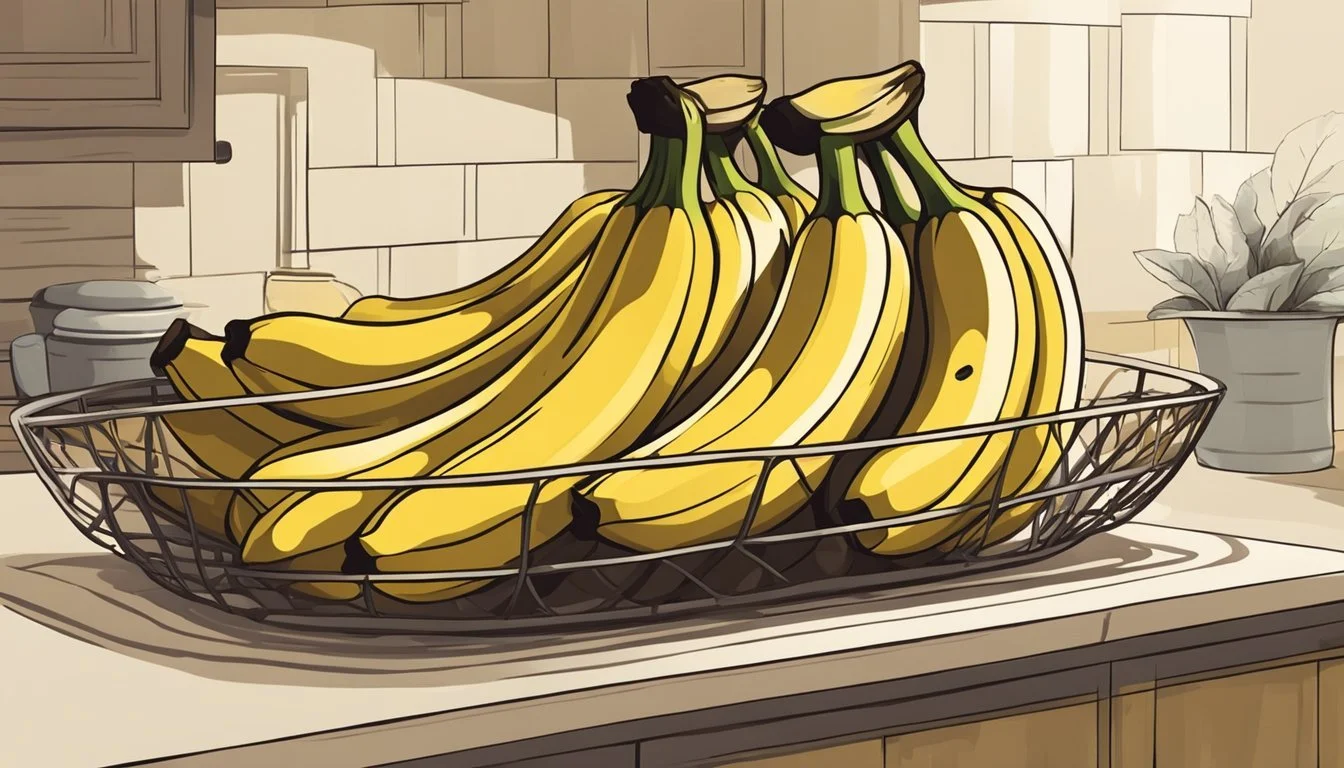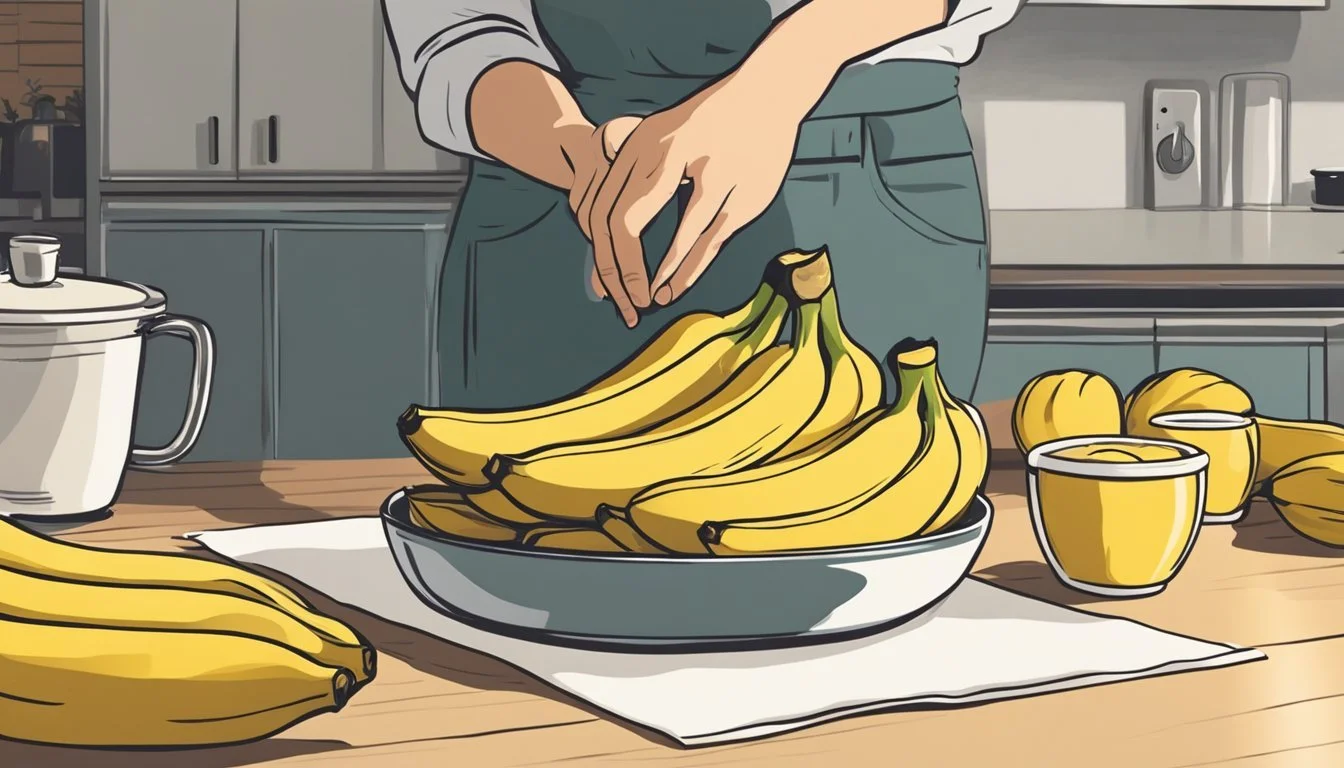How to Tell If a Banana Is Ripe
Your Ultimate Guide to Selecting Sweet Bananas
Determining the ripeness of a banana is essential to enjoying its flavor and nutritional benefits to the fullest. A ripe banana offers not just a sweet and enjoyable taste but also an array of health advantages, such as a boost in potassium and energy-providing carbohydrates. While underripe bananas may be harder and starchier, an overripe banana might be too mushy and sweet for some preferences. The signs of the ideal ripeness involve color, feel, and ease of peeling.
A banana signals its ripeness through several visual and tactile clues that anyone can quickly learn to recognize. The peel color transitions from green to yellow and then may develop brown spots, indicating increased sweetness. The fruit should yield slightly to pressure but not feel too soft, and the stem should snap easily when the banana is ready to be peeled. These characteristics provide not only the best eating experience but also ensure that the banana is at its peak for cooking or baking purposes.
Key Takeaways
Identifying ripe bananas is key to maximizing flavor and health benefits.
Ripe bananas display certain visual and textural indicators.
The banana's peel color, firmness, and ease of peeling highlight ripeness.
Understanding Banana Ripeness
When selecting bananas, recognizing the level of ripeness is critical to ensure the fruit's taste and texture meet expectations. The ripeness of bananas affects their sweetness, firmness, and overall flavor.
Stages of Banana Ripeness
Bananas progress through distinct stages from underripe to overripe. They start as green bananas, which are firm and have a starchier taste. As they ripen, they transition to a yellow banana with a sweeter flavor. The presence of brown spots indicates that a banana is approaching an overripe state, which is often the sweetest and most fragrant stage.
Color as an Indicator of Ripeness
Green: The banana is underripe and may taste bland or have a slightly bitter flavor.
Greenish-Yellow: The fruit is almost ripe, possessing a mild sweetness suitable for cooking.
Yellow with small brown spots: This color signals a fully ripe banana, ideal for eating raw.
Yellow with many brown spots: Indicates very ripe bananas, with increased sweetness.
Brown: Overripe bananas, often too soft for eating raw but perfect for baking.
Texture and Firmness
A ripe banana should have a texture that is firm but yields to slight pressure, making it easy to peel. An underripe banana will feel quite hard, whereas an overripe one may feel mushy.
Aroma and Smell
The aroma of bananas intensifies with ripeness. Green bananas may lack noticeable smell, but ripe bananas emit a sweet and fruity scent. An overly ripe banana's smell will be significantly stronger and may indicate the presence of fermenting sugars.
Health and Nutrition in Bananas
Bananas are a rich source of nutrients that vary with ripeness. They are known to offer different health benefits at different stages — from green to fully ripe — providing a versatile profile of nutrition and health advantages.
Nutritional Content by Ripeness Level
Green Bananas:
Starch: Predominantly composed of starch which makes them less sweet.
Fiber: A high fiber content, beneficial for blood sugar control and digestive health.
Resistant Starch: Functions as a prebiotic, promoting gut health.
Yellow Bananas (Ripe):
Sugars: Higher sugar content as starch converts to simple sugars, making them sweeter.
Antioxidants: Increased levels of antioxidants as they ripen.
Potassium: Contains approximately 450mg of potassium, essential for heart health and blood pressure regulation.
Calories: Green Banana - 89, Ripe Banana - 89
Water: Green Banana - 75%, Ripe Banana - 75%
Protein (g): Green Banana - 1.1, Ripe Banana - 1.1
Carbohydrates (g): Green Banana - 22.8, Ripe Banana - 22.8
Fiber (g): Green Banana - 2.6, Ripe Banana - 2.6
Fat (g): Green Banana - 0.3, Ripe Banana - 0.3
Sugar (varying level): Green Banana - Less, Ripe Banana - More
Health Benefits of Ripe vs Unripe Bananas
Unripe Bananas:
High in dietary fiber and resistant starch which may improve insulin sensitivity.
Lower in sugar, making them a suitable choice for people monitoring their sugar intake, such as those with diabetes.
Ripe Bananas:
Increased levels of antioxidants, which help to protect the body against free radicals and chronic diseases.
The presence of more simple sugars provides a quick energy boost and enhances their natural sweetness.
Both ripe and unripe bananas contribute significantly to daily nutritional intake, providing vitamins and minerals necessary for overall health. They are a healthy snack option with varying benefits at each stage of ripeness.
How to Choose Ripe Bananas
When selecting bananas, consumers look for key features indicating ripeness—ideal color, texture, and aroma—for an immediately enjoyable fruit or for one that will ripen to perfection at home.
Selecting Bananas at the Grocery Store
At the grocery store, one should focus on the color of the banana's skin. Fully ripe bananas typically possess a bright yellow hue, whereas a greenish tone suggests under-ripeness. Overripe bananas may have numerous dark brown spots. When looking for bananas to consume shortly, choose those with a consistent yellow color. If the intention is to consume them over several days, selecting bananas with a slight green tint at the stem can be beneficial. They will continue to ripen after purchase.
Next comes the feel test. Gently squeeze a banana to gauge its firmness. Bananas that are neither too hard nor too soft are generally just right. Overly firm bananas will lack the creaminess and taste that comes with ripeness, while mushy bananas might be too far gone and have an overly sweet or fermenting flavor.
Identifying Signs of Perfect Ripeness
Color and Texture:
Bright yellow with no green at the edges indicates a ripe banana.
Soft to the touch but not mushy signifies ripeness.
Aroma:
A ripe banana emits a sweet and fruity scent. If one detects a strong sweet smell without hints of sourness or fermentation, the banana is likely at the peak of ripeness.
A ripe banana should detach from the stem with moderate ease, signaling its readiness to be eaten. Overripe bananas may come away too easily and could be more suitable for baking purposes than fresh consumption.
By paying attention to these indicators, shoppers can confidently select ripe bananas that will provide the best flavor and texture.
Ripening Bananas at Home
When one wants to accelerate ripening or extend the shelf life of bananas, specific techniques can be employed at home to manage the ripeness of the fruit effectively.
Accelerating the Ripening Process
To quicken the ripening of green bananas, the use of ethylene gas, which bananas naturally produce, is a go-to strategy. Home ripening can be accelerated by:
Encasing bananas in a paper bag: Trapping ethylene gas around the bananas.
Adding an apple: Apples release ethylene, which can speed up the process.
Using warmth: Storing bananas in a warm spot, like a sunny windowsill, facilitates faster ripening.
For more immediate results, one can use the oven method:
Preheat the oven to 300°F (150°C).
Line a baking sheet with parchment.
Place unripe bananas on the sheet and bake for 30 minutes or until the skin darkens.
Extending Shelf Life
To preserve the shelf life of ripe bananas, one can employ various techniques to slow down the ripening:
Refrigeration: Ripe bananas can be stored in the fridge; the skin may darken, but the fruit will remain unchanged.
Stem Wrapping: Covering the stems in plastic wrap diminishes ethylene's effect, slowing ripening considerably.
Storage Techniques
The manner in which bananas are stored can affect their rate of ripening:
Separation: Separate bananas from the bunch to slow down ripening as isolated bananas produce less ethylene.
Room Temperature Storage: Store bananas at room temperature until they reach the desired level of ripeness.
Hanging: By hanging bananas on a banana hanger, they avoid bruising and ripen evenly.
Using these methods, individuals can ensure bananas achieve the perfect balance of sweetness and texture, catered to their taste and timing preferences.
Preparing and Using Ripe Bananas
Once bananas reach their peak ripeness, they offer a perfect balance of sweetness and creaminess, making them versatile for a variety of culinary uses. The following subsections provide detailed guidance on how to prepare and integrate ripe bananas into various dishes and treats.
Peeling and Slicing Techniques
To peel a ripe banana, one should snap the stem or gently press the top until the peel splits. With a ripe banana, the peel should come away easily. For slicing, a sharp knife is recommended to ensure clean cuts without squashing the fruit. Slices of ripe banana can be:
Circular: for topping cereals or as a snack.
Lengthwise: for sandwiches or decorative plating.
Bananas in Recipes
Ripe bananas are a baker's delight, imparting natural sweetness and moisture to a range of recipes. They can be mashed and incorporated into:
Banana bread: where their creaminess enriches the batter.
Pancakes: as a substitute for some liquid ingredients, while adding flavor.
Ripe bananas also complement savory dishes, such as:
Sautéed bananas: to accompany meats or as a dessert topping.
Making Smoothies and Other Treats
For a banana smoothie:
Combine ripe banana slices in a blender.
Add liquid (milk or a dairy-free alternative).
Blend until smooth.
Banana ice cream is another treat easily made with frozen ripe banana slices, blended until they reach an ice cream-like consistency without the need for added sugars.
Recognizing Overripe Bananas
When bananas pass their prime, they become overripe, exhibiting certain telltale signs. Identifying these bananas ensures their optimal use and prevents unnecessary waste.
When to Use Overripe Bananas
Overripe bananas can be distinguished by their black spots and extensive bruises that often merge into larger discolored areas. These bananas are very easy to peel, and the flesh may be soft and mushy. Contrary to being discarded, overripe bananas are ideal for cooking and baking applications; their heightened sweetness and moisture level make them perfect for banana bread, muffins, and smoothies.
Avoiding Waste
To minimize waste, it's important to use ripe bananas effectively and to understand when they can still be consumed:
Black Peel: If a banana's peel has turned black but the inside has not yet reached that stage, it can still be eaten or used for cooking.
Mold Presence: Any banana showing signs of mold should be discarded for health safety reasons.
Leakage: Bananas that have started to leak liquid are past the point of consumption and should not be eaten.
Storage Tips:
Freezing: Overripe bananas can be peeled and frozen for later use in recipes.
Refrigeration: Slows down the ripening process if you can't use the bananas immediately.
By recognizing and utilizing overripe bananas, not only does one enhance the flavor of countless recipes, but also significantly reduces food waste.




